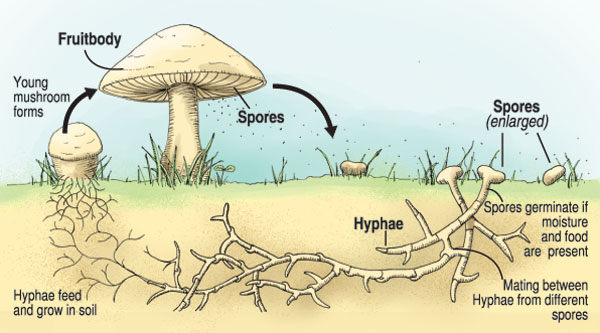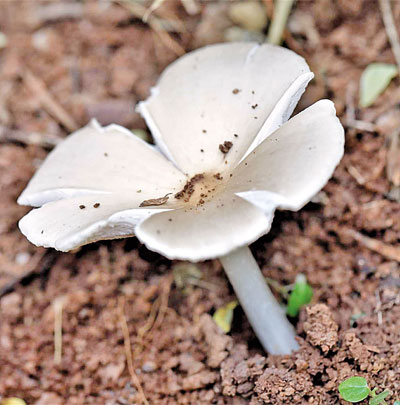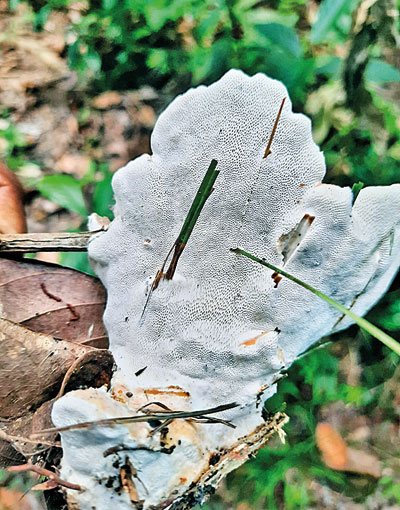News
New mushroom species found in home gardens and university
View(s):By Malaka Rodrigo
The rain has become a hassle for most Sri Lankans these days, but keep an eye on your garden as these damp conditions could wake up sleeping mushroom beauties.
“Sri Lanka has very good mushroom diversity, but as these are largely understudied, perhaps the mushroom in your garden too can be a species new to science,” says Dr Aseni Ediriweera, a scientist who studies mushrooms.

Dr Ediriweera made this comment as two mushroom species new to science that she discovered recently were not from wilderness or wetlands, but one from a home garden and another from the busy premises of the University of Ruhuna. The mushroom found in the University of Ruhuna was named Candolleomyces ruhunensis by the research team after the university, and the mushroom found in the home garden was named Termitomyces srilankensis.
The Termitomyces srilankensis mushroom was first found by nature photographer Hemachandra Kularathne from his home garden in Kegalle. He shared the photos with Dr Ediriweera, whose further studies confirmed it is also a mushroom new to science. Quite interestingly this has been an edible mushroom that villagers commonly called ‘weli hathu’ and Mr Kularathne’s family would have enjoyed the delicacy of these endemic wild mushrooms for generations.
There are several species of mushrooms called ‘weli hathu’ which are called ‘Termite mushrooms’ in English. They grow near termite colonies. This has a scientific reason, as these mushrooms have a symbiotic mutually beneficial relationship with termites, says Dr Ediriweera. Termites feed on spores or the tiny seeds of mushrooms and as they use their faecal matter to build nests, they naturally provide a substrate for the mushroom to grow. During the rainy seasons, these fungi fruit as a response to adequate moisture and nitrogen levels in soils, Dr Ediriweera said.

Termitomyces srilankensis - the edible mushroom found in a home garden in Kegalle
There are several other varieties of edible wild mushrooms, and those who lived in a by-gone era knew how to distinguish wild mushrooms from the poisonous ones, but that traditional knowledge is mostly lost, said Prof Samantha Karunarathna, another Sri Lankan mushroom expert now at Thailand University.
“I have also noticed people have a lot of misleading folklore regarding edible/poisonous mushrooms, so the country urgently needs a proper mushroom guidebook,” Prof Karunarathna told the Sunday Times.
Mushrooms are fungi that silently grow on moist soil, leaf litter or on decaying woods as tiny threadlike strands. These strands form colonies that are scientifically called mycelium. The familiar fleshy part that emerges from soil is the fruiting of this fungi colony. The mushroom produces millions of tiny particles called spores usually under its hood. When these spores land on a new place, they start creating a new fungi mycelium colony.
Not just mushrooms, Sri Lanka needs to enhance studies on fungi urgently, says Prof Karunarathna. The predicted number of fungal species in Sri Lanka is about 34,000, but only about 2,500 species are known. There are only new publications related to fungi published in recent years, so the scientific effort too, should be increased as some species might become extinct before being discovered due to climate change and many other factors, Prof Karunarathna added.
Compared to the past, we do not get enough mushrooms.
“This is mainly due to changes in soil biology and soil chemistry,” points out Dr Ediriweera.
Soil chemistry has drastically changed due to the addition of excessive amounts of chemicals. Chemicals change the composition of soil by changing the concentration of nitrogen and phosphorus which are highly significant to mushrooms.

Perenniporiopsis srijayewardenepurana - the mushroom discovered in Kadawatha
The microbial community supports the balance of ecosystems that is destroyed by chemical additions. Due to less diversity of soil microorganisms, the supportive mechanisms for the growth of mushrooms become weak, so their numbers also decrease, Dr Ediriweera said.
Meanwhile, to raise interest on mushroom studies, a workshop on mushroom identification and best practices in taking high quality mushroom photographs for undergraduates and post-graduates was recently held in the faculty of technology of the Rajarata University. Experts Stephen Axford and Catherine Marciniak from Planet Fungi which promotes fungi studies were in Sri Lanka. “Even a mobile phone can be used to photograph the fungi, and our goal was to teach these scientists how to take accurate, identifiable and aesthetically pleasing fungi photographs, especially using the camera on a phone,’’ the experts stated.
The latest addition to mushroom from a home garden is from Kadawatha.
A few weeks ago researcher Kasun Thambugala described another woody mushroom that grows on decaying timber and named it Perenniporiopsis srijayewardenepurana after the Sri Jayewardenepura University. Quite interestingly, Dr Thambugala first found this mushroom from his own home garden in Kadawatha, and is urging the public, too, to be more vigilant of the largely unexplored world of mushrooms and fungi.
The best way to say that you found the home of your dreams is by finding it on Hitad.lk. We have listings for apartments for sale or rent in Sri Lanka, no matter what locale you're looking for! Whether you live in Colombo, Galle, Kandy, Matara, Jaffna and more - we've got them all!

